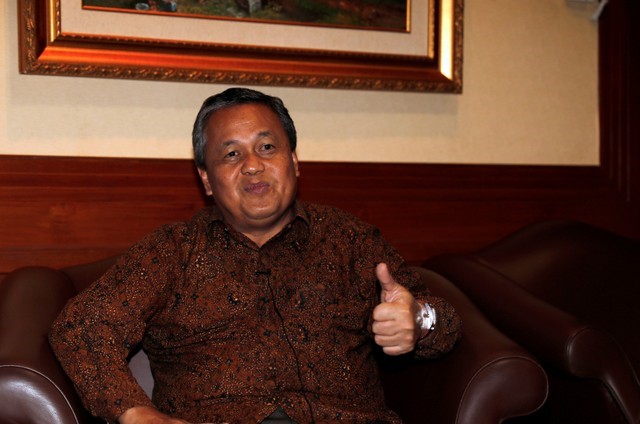
Bank Indonesia’s new governor Perry Warjiyo gestures during an interview at Bank Indonesia’s headquarters in Jakarta, Indonesia, July 9, 2018. REUTERS/Beawiharta
July 9, 2018
By Gayatri Suroyo and Ed Davies
JAKARTA (Reuters) – Indonesia’s central bank governor said on Monday assessments of the domestic economy and global indicators would determine whether monetary policy needed to be tightened further, after three rate increases in two months to defend the currency.
In an interview, Bank Indonesia (BI) Governor Perry Warjiyo said rate rises had made returns on assets in Southeast Asia’s biggest economy more attractive, noting that investors had started to re-enter the government bond market.
On June 29, BI raised its benchmark rate by 50 basis points to stem a sell-off rattling emerging markets, caused by factors ranging from rising U.S. interest rates to a brewing global trade war.
Asked whether there was still room to raise Indonesia’s rates, Warjiyo said: “Well of course we will continue assessing the development of the domestic economy and global indicators to determine the policy”.
Warjiyo said that the current benchmark rate of 5.25 percent, following 100 bps of increases so far this year, assumed that the Federal Reserve would raise rates four times this year and three times in 2019.
BI also assumed the yield on the U.S. Treasury notes would be 3.35 percent at the end of this year, up from around 2.8 percent now.
Outflows from Indonesia’s government bond market continued in June for a third consecutive month, though they declined from May. Foreign ownership of government debt is around 38 percent.
“We are quite confident returns on Indonesia’s financial assets, especially government bonds are quite attractive, competitive compared to other peer groups,” Warjiyo said.
The yield on Indonesia’s benchmark 10-year bond <ID10YT=RR> hit 7.823 percent at the end of June – the highest since January 2017, up from around 6 percent at the start of 2018. The yield closed at 7.499 percent on Monday.
Indonesia is among the emerging markets vulnerable to capital outflows. Foreign bond ownership is high and it runs a persistent current account deficits.
“We are addressing the issue of current account, the need for .. import substitution as well as promoting tourism and how to continue to promote FDI (foreign direct investment),” Warjiyo told Reuters.
“I think a series of policies will be issued in this juncture,” he said, without elaborating.
Indonesia’s current account gap is expected to widen to more than 2 percent of GDP this year from 1.7 percent in 2017, BI has forecast.
Indonesia’s central bank has outpaced other vulnerable Asian markets, such as the Philippines and India, in its pace of rate increases to respond to capital outflows.
The rupiah has lost about 5 percent of its value against the dollar so far this year.
BI’s foreign exchange reserves declined $12.2 billion in February through June, partly from being used for currency intervention, to $119.8 billion, the lowest in 17 months.
Analysts now appear divided over the outlook for Indonesia’s benchmark rate. DBS Bank on Monday said it expected another 50 bps increase this year; Morgan Stanley sees no further change this year.
(Additional reporting by Maikel Jefriando, editing by Larry King)

